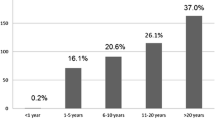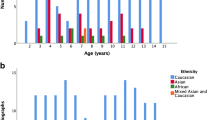Abstract
Background
Bone age in infants (<1 year old) is generally estimated using hand/wrist or knee radiographs, or by counting ossification centers. The accuracy and reproducibility of these techniques are largely unknown.
Objective
To develop and validate an infant bone age estimation technique using fibular shaft length and compare it to conventional methods.
Materials and methods
We retrospectively reviewed negative skeletal surveys of 247 term-born low-risk-of-abuse infants (no persistent child protection team concerns) from July 2005 to February 2013, and randomized them into two datasets: (1) model development (n = 123) and (2) model testing (n = 124). Three pediatric radiologists measured all fibular shaft lengths. An ordinary linear regression model was fitted to dataset 1, and the model was evaluated using dataset 2. Readers also estimated infant bone ages in dataset 2 using (1) the hemiskeleton method of Sontag, (2) the hemiskeleton method of Elgenmark, (3) the hand/wrist atlas of Greulich and Pyle, and (4) the knee atlas of Pyle and Hoerr. For validation, we selected lower-extremity radiographs of 114 normal infants with no suspicion of abuse. Readers measured the fibulas and also estimated bone ages using the knee atlas. Bone age estimates from the proposed method were compared to the other methods.
Results
The proposed method outperformed all other methods in accuracy and reproducibility. Its accuracy was similar for the testing and validating datasets, with root-mean-square error of 36 days and 37 days; mean absolute error of 28 days and 31 days; and error variability of 22 days and 20 days, respectively.
Conclusion
This study provides strong support for an infant bone age estimation technique based on fibular shaft length as a more accurate alternative to conventional methods.











Similar content being viewed by others
References
Black S, Aggrawal A, Payne-James J (2011) Age estimation in the living: the practitioner’s guide. Wiley, London
Cox LA (1997) The biology of bone maturation and ageing. Acta Paediatr Suppl 423:107–108
Greulich WW, Pyle SI (1959) Radiographic atlas of skeletal development of the hand and wrist, 2nd edn. Stanford University Press, Stanford
Tanner J, Whitehouse R, Cameron N et al (1975) Assessment of skeletal maturity and prediction of adult height (TW2 method), 2nd edn. Academic, London
De Roo T, Schroder HJ (1976) Pocket atlas of skeletal age. Martinus Nijhoff Medical Division, The Hague
Gilsanz V, Ratib O (2005) Hand bone age: a digital atlas of skeletal maturity. Springer, Berlin
Willems G (2001) A review of the most commonly used dental age estimation techniques. J Forensic Odontostomatol 19:9–17
Garamendi PM, Landa MI, Botella MC et al (2011) Forensic age estimation on digital X-ray images: medial epiphyses of the clavicle and first rib ossification in relation to chronological age. J Forensic Sci 56:S3–S12
Schulz R, Mühler M, Reisinger W et al (2008) Radiographic staging of ossification of the medial clavicular epiphysis. Int J Leg Med 122:55–58
Charles YP, Dimeglio A, Canavese F et al (2007) Skeletal age assessment from the olecranon for idiopathic scoliosis at Risser grade 0. J Bone Joint Surg Am 89:2737–2744
Reem J, Carney J, Stanley M et al (2009) Risser sign inter-rater and intra-rater agreement: is the Risser sign reliable? Skeletal Radiol 38:371–375
Wittschieber D, Vieth V, Domnick C et al (2013) The iliac crest in forensic age diagnostics: evaluation of the apophyseal ossification in conventional radiography. Int J Legal Med 127:473–479
Michelson N (1934) The calcification of the first costal cartilage among whites and negroes. Hum Biol 6:543–557
Stiehl J, Muller B, Dibbets J (2009) The development of the cervical vertebrae as an indicator of skeletal maturity: comparison with the classic method of hand-wrist radiograph. J Orofac Orthop 70:327–335
Santiago RC, de Miranda Costa LF, Vitral RW et al (2012) Cervical vertebral maturation as a biologic indicator of skeletal maturity. Angle Orthod 82:1123–1131
Thevissen PW, Kaur J, Willems G (2012) Human age estimation combining third molar and skeletal development. Int J Legal Med 126:282–292
Pyle SI, Hoerr NL (1969) A radiographic standard of reference for the growing knee. Charles C. Thomas, Springfield
Dedouit F, Auriol J, Rousseau H et al (2012) Age assessment by magnetic resonance imaging of the knee: a preliminary study. Forensic Sci Int 217:232.e1–7
Hoerr NL, Pyle SI, Francis CC (1962) Radiographic atlas of skeletal development of the foot and ankle: a standard of reference. Charles C. Thomas, Springfield
Erasmie U, Ringertz H (1980) A method for assessment of skeletal maturity in children below one year of age. Pediatr Radiol 9:225–228
Sontag LW, Snell D, Anderson M (1939) Rate of appearance of ossification centers from birth to the age of five years. Am J Dis Child 58:949–956
Elgenmark O (1946) Normal development of the ossific centers during infancy and childhood: clinical, roentgenologic and statistical study. Acta Paediatr Scand 33:1–79
Strouse PJ, Keats TE (2008) Normal anatomy, growth, and development. In: Slovis T (ed) Caffey’s pediatric diagnostic imaging. Mosby, Philadelphia, pp 2545–2555
Laor T, Jaramillo D, Oestreich AE (1998) Musculoskeletal system. In: Kirks DR (ed) Practical pediatric imaging. Lippincott Williams & Wilkins, Philadelphia, pp 327–510
Sundick RI (1978) Human skeletal growth and age determination. Homo 29:228–249
Ubelaker DH (1978) Human skeletal remains: excavation, analysis, interpretation. Taraxacum, Washington DC
Maresh MM, Deming J (1939) The growth of the long bones in 80 infants. Roentgenograms versus anthropometry. Child Dev 10:91–106
Maresh MM (1955) Linear growth of long bones of extremities from infancy through adolescence: continuing studies. AMA Am J Dis Child 89:725–742
Klepinger L (2006) Fundamentals of forensic anthropology. Wiley, Hoboken
Rissech C, Schaefer M, Malgosa A (2008) Development of the femur — implication for age and sex determination. Forensic Sci Int 180:1–9
Lopez-Costas O, Rissech C, Trancho G, Turbon D (2012) Postnatal ontogenesis of the tibia. Implications for age and sex estimation. Forensic Sci Int 214:207.e1–e11
Breen MA, Tsai A, Kleinman PK (2015) Bone age assessment practices among SPR members: infants are not just little children. Pediatr Radiol 45:S110–S111
WHO Multicentre Growth Reference Study Group (2009) WHO child growth standards: growth velocity based on weight, length and head circumference: methods and development. World Health Organization, Geneva
Grummer-Strawn L, Reinold C, Krebs N (2010) Use of World Health Organization and CDC growth charts for children aged 0–59 months in the United States. MMWR Recomm Rep 59:1–15
American College of Radiology (2006) ACR practice guideline for skeletal surveys in children (Res. 47, 17, 35). In: American College of Radiology. ACR Standards. American College of Radiology, Reston, pp 203–207
Hackman L, Black S (2012) Does mirror imaging a radiograph affect reliability of age assessment using the Greulich and Pyle atlas? J Forensic Sci 57:1276–1280
Franklin D (2010) Forensic age estimation in human skeletal remains: current concepts and future directions. Leg Med 12:1–7
Smith SL, Buschang PH (2004) Variation in longitudinal diaphyseal long bone growth in children three to ten years of age. Am J Hum Biol 16:648–657
Smith SL, Buschang PH (2005) Longitudinal models of long bone growth during adolescence. Am J Hum Biol 17:731–745
Ghantus MK (1951) Growth of the shaft of the human radius and ulna during the first two years of life. AJR Am J Roentgenol 65:784–786
Anderson M, Green WT, Messer MB (1963) Growth and predictions of growth in lower extremities. J Bone Joint Surg 45A:1–14
Gindhard PS (1973) Growth standards for the tibia and radius in children aged one month through eighteen years. Am J Phys Anthropol 39:41–48
Goldman J, Salus MK, Wolcott D, Kennedy KY (2003) A coordinated response to child abuse and neglect: the foundation for practice. U.S. Department of Health and Human Services, Administration for Children and Families, Administration on Children, Youth and Families, Children’s Bureau, Office on Child Abuse and Neglect, Washington DC
Author information
Authors and Affiliations
Corresponding author
Ethics declarations
Conflicts of interest
None
Appendix
Appendix
Distribution of error estimates
The histograms of the estimated absolute errors from the knee and proposed fibular shaft length methods (with and without discretization) show the non-normal distribution of the data (Fig. 12), thus leading to the use of the non-parametric test for comparison.
Discretization of fibular shaft length method for fair comparison to the hand/wrist method
This method discretizes bone age at 0 months, 3 months, 6 months, 9 months and 12 months, with four intervals between these five ages. For each reader’s fibular shaft length-based estimates, a histogram was computed with four equally spaced bins (five bin edges). The median (across readers) center for each bin was used for the discretization. If an estimate was lower than the first bin center, bone age was set to 0. If it was between the first and second centers, second and third, third and fourth, or greater than the fourth center, it was set to 90 days, 180 days, 270 days and 360 days, respectively. The discretization was done separately for each reader as well as for the reader-averaged data. In the first case, the estimated histogram bin centers were 26.6 days, 111.4 days, 195.8 days and 280.2 days. Median bin width was 82 days. For the reader-averaged data, the histogram bin centers were at 41.2 days, 123.6 days, 206.1 days and 288.5 days.
Discretization of fibular shaft length method for comparison to the knee method
This method discretizes ages in the first 14–15 months of age unevenly at 0.03, 0.23, 0.5, 2.2, 5, 7.5, 11 and 15 months for girls, and 0.03, 0.33, 1, 3, 6, 9 and 14 months for boys.
Skeletal survey testing dataset
The minimum chronological age in this dataset was 5 days, which falls in the interval 0.03–0.23 month for girls and the interval 0.03–0.33 months for boys; and maximum chronological age was 364 days, which falls in the interval 11–15 months for girls and the interval 9–14 months for boys. Thus the 15-month and 14-month age points were included. A discretization of seven intervals for eight age points was selected for girls, six intervals for seven age points for boys. Bin edges were (in days) 0.0, 6.0, 14.0, 65.1, 149.1, 224.1, 329.1 and 449.1 days for girls; and 0.0, 9.0, 29.1, 89.1, 179.1, 269.1 and 419.1 days for boys. Corresponding bin centers were at 3.0, 10.1, 39.6, 107.1, 186.6, 276.6 and 389.1 days for girls, and 4.5, 19.1, 59.1, 134.1, 224.1 and 344.1 days for boys.
Normal infant validation dataset
The minimum chronological age in this dataset was 17 days, which falls in the interval 0.5–2.2 months for girls and the interval 0.33–1 month for boys; and maximum chronological age was 364 days, which falls in the interval 11–15 months for girls and the interval 9–14 months for boys. Thus the 15-month and 14-month age points were included. A discretization of five intervals for six age points was selected for girls, five intervals for six age points for boys. Because the scale in this method uses unequal intervals, estimated ages were also discretized using unequal intervals. For each reader, the ranges of model-based ages were used to estimate six edges of five bins for girls and boys, respectively. The median (over readers) edges were selected for the discretization. Resulting bin edges were (in days) 27.1, 78.1, 162.1, 237.1, 342.1 and 462.1 days for girls; and 27.2, 47.3, 107.3, 197.3, 287.3 and 437.3 days for boys. Corresponding bin centers were at 52.6, 120.1, 199.6, 289.6 and 402.1 days for girls; and 37.3, 77.3, 152.3, 242.3 and 362.3 days for boys.
Rights and permissions
About this article
Cite this article
Tsai, A., Stamoulis, C., Bixby, S.D. et al. Infant bone age estimation based on fibular shaft length: model development and clinical validation. Pediatr Radiol 46, 342–356 (2016). https://doi.org/10.1007/s00247-015-3480-z
Received:
Revised:
Accepted:
Published:
Issue Date:
DOI: https://doi.org/10.1007/s00247-015-3480-z





